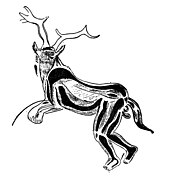Cave Of The Trois-Frères
Artwork


One of the paintings, known as "The Sorcerer", is the "most famous and enigmatic human figure" with the features of several different animals, whose exact characteristics remain a matter of debate.
Engravings featuring what appear to be several birds and a cave cricket were found on a fragment of bison bone at the junction of Trois-Frères with the Grotte d'Enlène. The cave cricket was portrayed with such fidelity that the insect's species has been determined. It is thought to be the earliest known representation of an insect.
A variety of engraved animals are found on the cave walls, including lions, owls, and bison. Of particular note is a horse overlaid with claviform (club-like) symbols, and an apparently speared brown bear vomiting blood.
Aside from the "Sorcerer", other human-like figures can be seen at Trois-Frères, such as the man-bison, and a character known as the "small sorcerer" who appears to be playing a nose-flute. Also of interest is an etched representation of a 59 cm long phallus that follows the contours of the cave walls.
Tuc d'Audoubert

The Trois-Freres cave is part of a single cave-complex formed by the Volp River. The complex is divided into three caves: the central Trois-Freres, Enlène (French pronunciation: [ɑ̃lɛn]) to the east, and the Tuc d'Audoubert (pronounced [tyk dodubɛʁ]) to the west.
The Tuc d'Audoubert was discovered by the three teenage brothers in 1912. The galleries are situated on three levels; the River Volp flows through the lowest, the middle contains decorated galleries known as the La Salle Nuptiale (The Bridal Room) and La Galerie des Gravures (The Gallery of Engravings), while the upper has further decoration in La Chatière and Salle des Talons (Hall of Claws) and finishes in the Salle des Bisons (Hall of Bisons). In 2013 the Tracking in Caves project tested experience based reading of prehistoric footprints by specialised trackers of Ju/'hoansi San with great success.
The Salle des Bisons contains two masterfully modeled bison, which were sculpted in clay with a stone spatula-like tool and the artist's fingers. The pair are among the largest and finest surviving prehistoric sculptures.
References
- ^ "Young Folks Find Cave Art". The Independent Record. August 15, 1957. p. 12. Retrieved November 13, 2021 – via Newspapers.com.
- ^ "Trois Freres". Encyclopedia britannica. Retrieved December 27, 2016.
- ^ "Trois Freres Cave, Ariege: Sorcerer Rock Engraving". Visual-arts-cork com. Retrieved December 27, 2016.
- ^ Connell, Evan (2001). "Olduval & All That". The Aztec Treasure House. Washington, D.C.: Counterpoint. p. 37. ISBN 1-58243-162-0.
- ^ Bégouën H., 1929: À propos de l'idée de fécondité dans l'iconographie préhistorique, Bulletin de la Société préhistorique française, 26, 3, pp 197–199.
- ^ Sieveking, A., 1979: Cave Artists (Ancient Peoples and Places)
- ^ Breuil H., 1930: Un dessin de la grotte des Trois frères (Montesquieu-Avantès) Ariège, Comptes rendus des séances de l'Académie des Inscriptions et Belles-Lettres, 74e année, N. 3, 1930. pp. 261–264.
- ^ Bégouën E., Bégouën M., 2013a: Découverte d'un grand phallus gravé magdalénien dans la grotte des Trois-Frères (Ariège), Bulletin de la Société Préhistorique Française, Tome 110, numéro 1, janvier-mars 2013, p. 127–129.
- ^ Bégouën R., Clottes J., 1991: Portable and Wall Art in the Volp Caves, Montesquieu-Avantès (Ariège), Proceedings of the Prehistoric Society, 57, pp 65-79.
- ^ "'Tracking in caves': On the trail of pre-historic humans -- ScienceDaily". sciencedaily. Retrieved February 4, 2017.
- ^ Kleiner, Fred (2009). Gardner's Art through the Ages: The Western Perspective, Volume 1. Cengage Learning. p. 36. ISBN 978-0495573609.